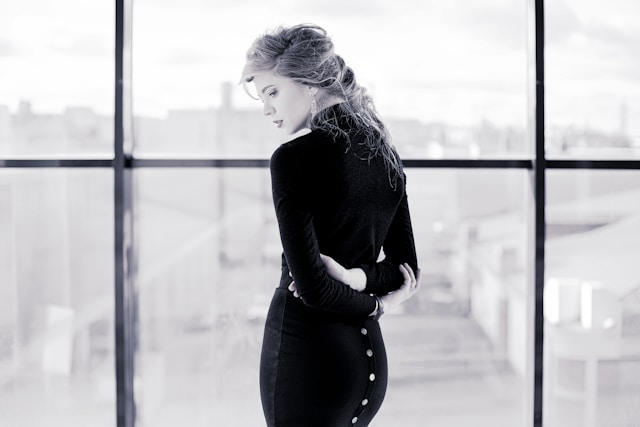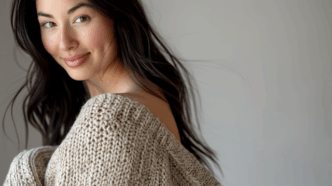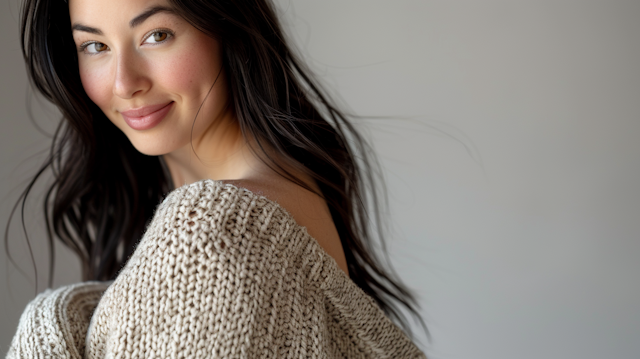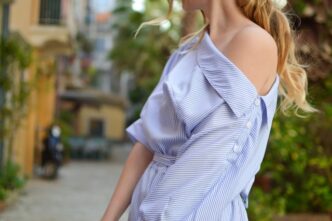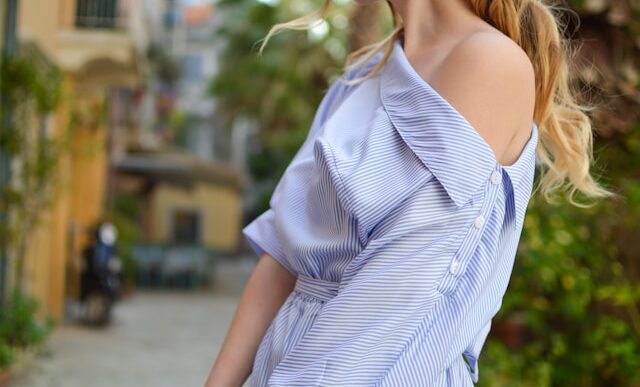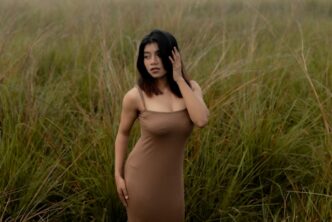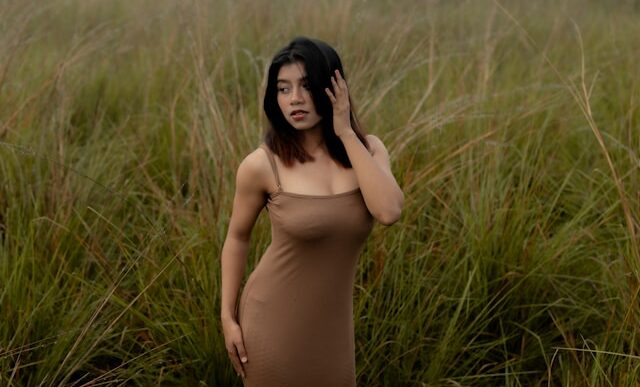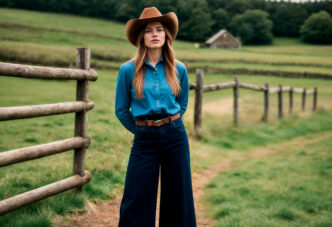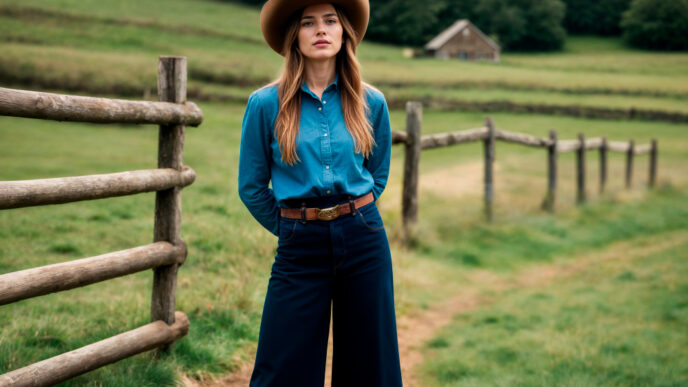Black dresses form the foundation of every woman’s wardrobe. These versatile pieces work for nearly any occasion. Learning how to style black dress creates endless outfit possibilities. This guide shows you different ways to wear these timeless pieces. You can dress them up for formal events or keep them casual for everyday wear. The key is choosing the right accessories and shoes to match your occasion.
Top 10 Black Dress Outfit Ideas
Creating stunning looks with black dresses means thinking about accessories, shoes, and layers that transform the basic piece into something special.
Black Dress with Statement Jewelry
Bold jewelry transforms a simple black dress into an eye-catching outfit. This approach works well for dinner parties and special events. Choose one statement piece as your focal point. Large earrings, chunky necklaces, or bold bracelets all work well.
Black dress outfit for women becomes instantly more interesting with the right jewelry. Pick pieces that complement the dress neckline. V-necks work well with pendant necklaces. High necklines look good with statement earrings. Keep other jewelry simple when wearing one bold piece.
The dress should be simple enough to let the jewelry shine. Avoid busy patterns or lots of details that compete with your accessories. Choose metals that you love and that work with your skin tone. Gold, silver, and rose gold all pair beautifully with black.
Make sure your jewelry is proportional to your body size. Petite frames look best with smaller statement pieces. Taller women can handle larger, more dramatic jewelry. The goal is balance between the dress, jewelry, and your natural proportions.
Black Dress with Blazer
Adding a blazer over a black dress creates instant sophistication. This combination works perfectly for work or business events. Choose blazers in colors that complement black like navy, gray, or white. The structured shoulders of a blazer add polish to any dress silhouette.
Black dress outfits gain professional appeal when you add tailored pieces. Make sure the blazer fits well through the shoulders and doesn’t pull across the chest. The sleeves should hit at your wrist bone when your arms hang naturally at your sides.
Choose dress lengths that work well under blazers. Knee-length or slightly below knee works best for most body types. Very short dresses might look inappropriate for work settings. Very long dresses can get bunched up under shorter blazers.
The blazer can be buttoned or left open depending on the dress style and your preference. Fitted dresses look good with open blazers. Looser dress styles might need a buttoned blazer to create more structure and definition around your waist.
Black Dress with Cardigan
Cardigans create cozy, approachable looks when paired with black dresses. This combination works well for casual outings and cooler weather. Choose cardigans in complementary colors or interesting textures that add visual appeal.
Women’s black dress outfits become more versatile with layering pieces like cardigans. Long cardigans work well with shorter dresses. Cropped cardigans pair nicely with longer dresses. Think about proportions when choosing cardigan lengths.
Button the cardigan completely for a more structured look. Leave it open for a relaxed, flowing silhouette. Tie the cardigan at the waist to create definition and show off your figure. Each styling method creates a different mood and level of formality.
Choose cardigans in fabrics that drape well and don’t add bulk. Thin knits work better than thick, chunky styles when layering over dresses. The cardigan should enhance the dress rather than hide its silhouette completely.
Black Dress with Denim Jacket
Denim jackets add casual cool to black dresses. This pairing works great for weekend activities and informal gatherings. Choose classic blue denim or try black denim for a monochromatic look. The contrast between formal dress and casual jacket creates interesting style tension.
How to style black dress in casual settings often involves adding relaxed pieces like denim. The jacket should fit well without being too tight across the shoulders or chest. You should be able to move your arms comfortably while wearing both pieces.
Roll up the jacket sleeves for a more relaxed feel. This also helps if the sleeves are slightly too long. Add casual shoes like sneakers or ankle boots to complete the laid-back vibe. Avoid overly formal shoes that clash with the casual jacket.
Consider the dress length when choosing denim jackets. Shorter jackets work well with most dress lengths. Longer jackets might overwhelm shorter dresses or create awkward proportions. Try different combinations to see what looks best on your body type.
Black Dress with Colorful Scarf
A bright scarf adds instant color and personality to a black dress. This approach works well when you want to brighten up a simple outfit. Choose scarves in colors that you love and that complement your skin tone.
How to wear black dress with accessories includes scarves as versatile styling tools. Wrap them around your neck for traditional styling. Tie them around your waist as a belt for definition. Drape them over your shoulders for light coverage and color.
The scarf pattern and texture should work well with the dress style. Simple dresses can handle bold patterns. Dresses with details might look better with solid colored scarves. Silk scarves add elegance while cotton scarves feel more casual.
Make sure the scarf proportions work with your body size. Large scarves can overwhelm petite frames. Small scarves might get lost on taller women. Choose sizes that complement your natural proportions and the dress silhouette.
Black Dress with Belt
Adding a belt to a black dress defines your waist and creates flattering proportions. This technique works especially well with loose or straight-cut dresses. Choose belts in colors that either complement or contrast nicely with black.
Types of black dress for women include many styles that benefit from belting. A-line dresses look more fitted with belts. Shift dresses gain shape and definition. Wrap dresses might not need belts since they already define the waist naturally.
Wide belts create dramatic focal points and work well for special occasions. Thin belts offer subtle definition for everyday wear. Chain belts add glamour for evening events. Choose belt styles that match the formality level of your occasion.
Position the belt at your natural waist for the most flattering effect. This creates the longest leg line and most balanced proportions. Avoid placing belts too high or too low as this can make you look shorter or create unflattering silhouettes.
Black Dress with Tights and Boots
Tights and boots extend the wearing season for black dresses. This combination works well for fall and winter styling. Choose tights in colors that complement your outfit. Black, navy, or colored tights all work depending on your style preference.
What to wear with black dress in cooler weather often includes hosiery and boots for warmth and style. Opaque tights provide more coverage and warmth than sheer options. Patterned tights add visual interest but work best with simple dress styles.
Boot styles should complement the dress length and your leg proportions. Knee-high boots work well with shorter dresses. Ankle boots pair nicely with midi and maxi length dresses. Consider the boot heel height for comfort and appropriateness to your activities.
Make sure tights fit properly without bunching or sagging. Ill-fitting hosiery looks sloppy and feels uncomfortable. Choose quality tights that will last through multiple wears. Keep spare pairs on hand since tights can run or tear easily.
Black Dress with Heels and Clutch
Heels and a clutch create classic evening elegance with black dresses. This combination works perfectly for formal events, parties, and date nights. Choose heel heights that you can walk in comfortably throughout the entire event.
Black dress outfit ideas for women often feature this timeless pairing for special occasions. The heels should complement the dress style and your leg proportions. Pointed toes look elegant with most dress styles. Strappy sandals add interest and work well for evening events.
Choose clutch sizes that hold your essentials without looking too large or too small for your body size. The clutch color can match your shoes or provide a pop of color against the black dress. Metallic clutches work well for evening events.
Consider the event dress code when choosing heel heights and clutch styles. Very formal events might call for higher heels and smaller clutches. Less formal gatherings allow for more comfortable heel heights and practical clutch sizes.
Black Dress with Sneakers
Sneakers create unexpected casual cool when paired with black dresses. This combination works well for daytime activities and relaxed social events. Choose clean, stylish sneakers that look intentional rather than like an afterthought.
How to dress up black dress doesn’t always mean formal shoes. Sometimes casual footwear creates more interesting and comfortable outfits. White sneakers work well with most black dress styles. Colored sneakers can add personality if they complement your overall look.
The dress style should work well with casual footwear. Simpler dress styles usually look better with sneakers than very formal or detailed dresses. Consider the occasion and venue when deciding if sneakers are appropriate for your outfit.
Make sure the sneakers are clean and in good condition. Scuffed or dirty sneakers can make even expensive dresses look cheap. Keep your casual shoes looking fresh to maintain the overall outfit quality and your personal style standards.
Black Dress with Leather Jacket
Leather jackets add edge and attitude to black dresses. This pairing works well for concerts, casual dates, and night out with friends. Choose jackets that fit well through the shoulders and arms. The jacket should enhance your silhouette rather than hide it.
Black dress style tips include mixing different textures and styles for visual interest. The contrast between feminine dress and edgy jacket creates appealing style tension. Choose leather jacket styles that complement your personal aesthetic and comfort level.
The dress length should work well with shorter jackets. Most leather jackets hit at hip length or slightly below. Very long dresses might look awkward with shorter jackets. Consider proportions when planning this type of outfit combination.
Make sure you can move comfortably in both pieces. Leather jackets can be less flexible than other jacket types. Test your range of motion when trying on this combination. The jacket should allow comfortable arm movement for your planned activities.
Types and Styles of Black Dresses
Understanding different black dress options helps you choose pieces that work for your lifestyle and body type.
A-line black dresses feature fitted bodices that flow out from the waist. These universally flattering styles work well for most body types. The gentle flare creates feminine silhouettes while hiding hip areas some women prefer to minimize. A-line dresses work for both casual and formal occasions depending on fabric and details.
Sheath dresses follow the body’s natural lines closely. These fitted styles showcase curves and create sleek, sophisticated silhouettes. Sheath dresses work well for professional settings and cocktail events. They require proper undergarments for smooth lines and confident wearing.
Wrap dresses tie at the waist and create adjustable fits. These versatile styles flatter many body types by defining the waist and creating V-necklines. Wrap dresses work well for work, casual events, and special occasions. The adjustable tie allows for comfort throughout the day.
Shift dresses hang straight from the shoulders without much waist definition. These comfortable styles work well for casual wear and hot weather. Shift dresses can be dressed up with accessories and shoes or kept simple for everyday comfort. They work especially well on straighter body types.
Maxi dresses extend to ankle length for dramatic, flowing silhouettes. These elegant styles work well for formal events and summer occasions. Maxi dresses require attention to proportion and often look best with heels to prevent overwhelming shorter women.
Bodycon dresses fit very close to the body and show every curve. These sexy styles work well for parties and night out events. Bodycon dresses require confidence and proper undergarments for successful wearing. They work best on women comfortable showing their figure.
Off-shoulder dresses expose the shoulders while covering the arms. These romantic styles work well for date nights and special events. Off-shoulder dresses create elegant necklines and work well with statement earrings or necklaces.
Fit-and-flare dresses combine fitted bodices with flared skirts. These classic styles create hourglass silhouettes on most body types. Fit-and-flare dresses work well for work, social events, and date nights. They offer comfort with feminine appeal.
How To Choose The Best Black Dress
Finding the perfect black dress requires considering your body type, lifestyle, and personal style preferences.
Start by thinking about when and where you’ll wear the dress most often. Work environments might require different styles than social events. Consider your typical activities and choose dresses that work for your real life rather than ideal situations.
Try on different silhouettes to see what flatters your body type best. A-line styles work well for most figures. Fitted styles showcase curves. Flowing styles provide comfort and ease of movement. Don’t assume you know what will work best without trying different options.
Consider the dress length carefully. Knee-length dresses work for most occasions and body types. Shorter dresses might not be appropriate for all work environments. Longer dresses can overwhelm shorter women but look elegant on taller frames.
Look at fabric quality and care requirements. Natural fibers often look more expensive but may require special care. Synthetic blends might be easier to maintain but could look cheaper. Choose based on your lifestyle and maintenance preferences.
Check the dress construction and details. Well-made dresses have straight seams, quality zippers, and finished hems. Poor construction shows quickly in black fabrics. Invest in quality pieces that will maintain their appearance through multiple wears.
Consider how the dress will work with items you already own. Think about shoes, jackets, and accessories you have. Choose dresses that coordinate with your existing wardrobe for maximum versatility and value.
Seasonal Style Guide for Black Dresses
Black dresses work year-round with seasonal adjustments for weather and appropriate styling.
Spring Styling Approaches Spring black dress styling focuses on lighter fabrics and fresh accessories. Choose dresses in cotton, silk, or lightweight blends that feel appropriate for warmer weather. Add colorful accessories like scarves, jewelry, or shoes to brighten the black base.
Styles of black dress for spring include sleeveless or short-sleeved options that don’t feel too heavy. Pair with light cardigans or blazers for cooler spring days. Choose bright or pastel accessories that reflect the season’s renewal energy.
Layer spring dresses with denim jackets or light wraps for temperature changes throughout the day. Add comfortable flats or low heels for spring activities. Keep accessories fresh and light rather than heavy winter pieces.
Summer Styling Strategies Summer black dress styling emphasizes breathable fabrics and minimal layering. Choose dresses in cotton, linen, or moisture-wicking blends that keep you cool in hot weather. Black absorbs heat, so fabric choice becomes especially important.
Best practices for summer include choosing sleeveless or short-sleeved styles that provide good air circulation. Add sandals or canvas shoes for hot weather comfort. Keep accessories minimal to avoid feeling overwhelmed in high temperatures.
Use summer black dresses for air-conditioned environments where you need coverage but not warmth. Evening events work well for black dresses since temperatures often drop after sunset. Choose lighter accessories that don’t add heat or weight.
Fall Styling Techniques Fall black dress styling incorporates layers and richer accessories for cooler weather. Add tights, boots, and jackets to extend dress wearing into cooler months. Choose accessories in fall colors like burgundy, orange, or deep green.
Layer fall black dresses with cardigans, blazers, or light coats for temperature control. Add scarves for warmth and color. Choose boot styles that complement the dress length and your leg proportions.
Fall accessories can be richer and more substantial than summer options. Add statement jewelry, textured tights, or interesting shoes that work with cooler weather clothing. Keep layering pieces that can be removed if needed.
Winter Styling Solutions Winter black dress styling requires strategic layering for warmth while maintaining style. Add heavy tights, warm boots, and substantial coats for cold weather protection. Choose wool or heavier fabric dresses that provide base warmth.
Layer winter black dresses under coats and heavy jackets. Add scarves, hats, and gloves that complement the overall outfit. Choose winter accessories that coordinate with your coat and shoe colors.
Consider dress sleeve length for winter wearing. Long sleeves provide more warmth than sleeveless styles. Layer short-sleeved dresses over long-sleeved shirts or under warm cardigans for additional coverage and warmth.
Do’s and Don’ts of Wearing Black Dresses
Following these guidelines helps you look polished and feel confident in black dresses.
Essential Do’s for Black Dress Styling
Do invest in quality black dresses that maintain their color and shape through multiple wears. Cheap black fabrics often fade to gray or develop a rusty tinge over time. Quality pieces keep their true black color and crisp appearance through proper care.
Do choose fits that flatter your body type and feel comfortable for extended wearing. Black shows every fit issue clearly, so proper sizing becomes especially important. Take time to find cuts that work well for your proportions and activity level.
Do consider the occasion and dress code when styling black dresses. What works for casual weekend activities might not be appropriate for work or formal events. Match your styling choices to the event requirements and social expectations.
Do pay attention to undergarments since black dresses can be unforgiving. Choose seamless options that don’t create visible lines. Make sure bras and shapewear work well with the dress neckline and fit. Proper foundation garments make any dress look better.
Do experiment with different accessories to create variety from the same dress. Black provides a neutral base that works with many colors and styles. Change your shoes, jewelry, and layers to create different looks from one basic piece.
Important Don’ts to Avoid
Don’t wear black dresses that are too tight or too loose for your body type. Ill-fitting clothes look unflattering regardless of color, but black emphasizes fit problems. Choose sizes that allow comfortable movement without excess fabric bunching or pulling.
Don’t ignore fabric care instructions that maintain the dress color and shape. Black fabrics can be particular about washing and storage. Follow care labels to prevent fading, shrinking, or damage that shortens the dress lifespan.
Don’t wear the same black dress styling repeatedly without variation. While black dresses are versatile, wearing them exactly the same way every time looks boring. Change accessories, shoes, or layers to create fresh looks.
Don’t forget about proportion when adding accessories or layers to black dresses. The dress should remain the focus while accessories enhance rather than overwhelm. Balance is key to successful styling with any clothing color.
Don’t assume all black dresses work for every occasion. Consider factors like dress length, neckline, fabric, and overall styling when choosing outfits for different events. Some black dresses work better for casual wear while others suit formal occasions.
7 Tips on How to Wear Black Dress
These practical suggestions help you get the most style value from your black dress collection.
Tip 1: Choose Quality Fabrics Investing in well-made black dresses pays off through better appearance and longer wear life. Quality fabrics maintain their color intensity and structural integrity through multiple cleanings. Look for natural fibers or high-quality blends that drape well and resist fading.
Black dress style guide experts recommend checking fabric content and construction before purchasing. Well-made seams, quality zippers, and properly finished hems indicate pieces that will maintain their appearance over time and justify their cost through extended wear.
Tip 2: Master the Art of Accessorizing Black dresses provide perfect canvases for accessories that express your personality and style preferences. Start with one focal point piece like statement jewelry or colorful shoes. Build the rest of your accessories around that main element to create cohesive looks.
Recommendations include developing a collection of versatile accessories that work with multiple black dress styles. Quality shoes, jewelry, and bags in various styles let you create many different looks from basic black dress foundations.
Tip 3: Pay Attention to Fit and Silhouette Proper fit makes the difference between looking polished and looking sloppy in black dresses. The color shows every fitting issue clearly, making proper sizing crucial for successful styling. Take time to find brands and cuts that work well for your body type.
Look for dresses that fit well in key areas like shoulders, bust, and waist. These areas are hardest to alter and most important for overall appearance. Minor length adjustments are easier to make than major fitting changes.
Tip 4: Consider Seasonal Appropriateness Adapting black dress styling to different seasons keeps your outfits feeling current and weather-appropriate. Summer black dresses should be lightweight and breathable. Winter versions can be heavier and work well with substantial layering pieces.
Stylish seasonal transitions involve changing accessories, shoes, and layers rather than completely different dresses. One quality black dress can work across multiple seasons with thoughtful styling adjustments for weather and social expectations.
Tip 5: Build a Versatile Collection Rather than buying many similar black dresses, choose different styles that serve various purposes in your lifestyle. Include casual, work-appropriate, and formal options in cuts that flatter your figure and work for your typical activities.
Flattering variety might include an A-line dress for general wear, a sheath dress for work, and a more formal style for special occasions. This approach gives you options while preventing wardrobe redundancy and wasted money.
Tip 6: Learn Proper Care Techniques Black fabrics require specific care to maintain their color intensity and prevent fading or damage. Wash similar colors together and avoid over-washing pieces that can be aired out between wears. Store black dresses properly to prevent color transfer and shape distortion.
Elegant preservation includes using quality hangers that support the dress structure. Fold knit dresses to prevent stretching. Keep black dresses away from direct sunlight during storage to prevent color fading over time.
Tip 7: Experiment with Different Styling Approaches Don’t limit yourself to traditional black dress styling methods. Try unexpected combinations like black dresses with colorful tights, casual shoes with formal dresses, or layering pieces in interesting ways that create fresh looks.
Classic pieces like black dresses work well with both traditional and contemporary styling approaches. Mix formal and casual elements thoughtfully to create outfits that feel current while maintaining the timeless appeal that makes black dresses wardrobe staples.
Modern trends often involve unexpected styling combinations that breathe new life into classic pieces. Stay open to trying different approaches while maintaining your personal style preferences and comfort level with various looks.
Best Alternatives to Black Dresses
When black dresses don’t suit your needs, these alternatives provide similar versatility with different aesthetic appeals.
Navy Dresses offer similar versatility to black while feeling slightly softer and more approachable. Navy works well in professional settings and coordinates beautifully with many colors. These pieces work especially well for daytime events where black might feel too formal or heavy.
Gray Dresses provide neutral foundations that work with many accessories while feeling more casual than black. Light gray works well for spring and summer while darker grays suit fall and winter styling. Gray dresses often photograph better than black in certain lighting conditions.
Burgundy Dresses create rich, sophisticated alternatives that work especially well during fall and winter months. This deep red shade coordinates with many neutral accessories while providing more color interest than basic black pieces.
Dark Green Dresses offer elegant alternatives that work well with gold accessories and warm-toned shoes. Forest or emerald green provides sophisticated color while maintaining the versatility that makes black dresses popular wardrobe choices.
Conclusion
Black dresses earn their place as wardrobe essentials through unmatched versatility and timeless appeal. These pieces work across seasons, occasions, and style preferences when chosen and styled thoughtfully.
Success with black dresses comes from investing in quality pieces that fit well and learning to accessorize them effectively for different occasions. The key lies in building a small collection of well-chosen styles rather than many similar pieces.
By following these guidelines and experimenting with different combinations, you can maximize the style potential of black dresses while creating looks that reflect your personal aesthetic and meet your lifestyle needs.

